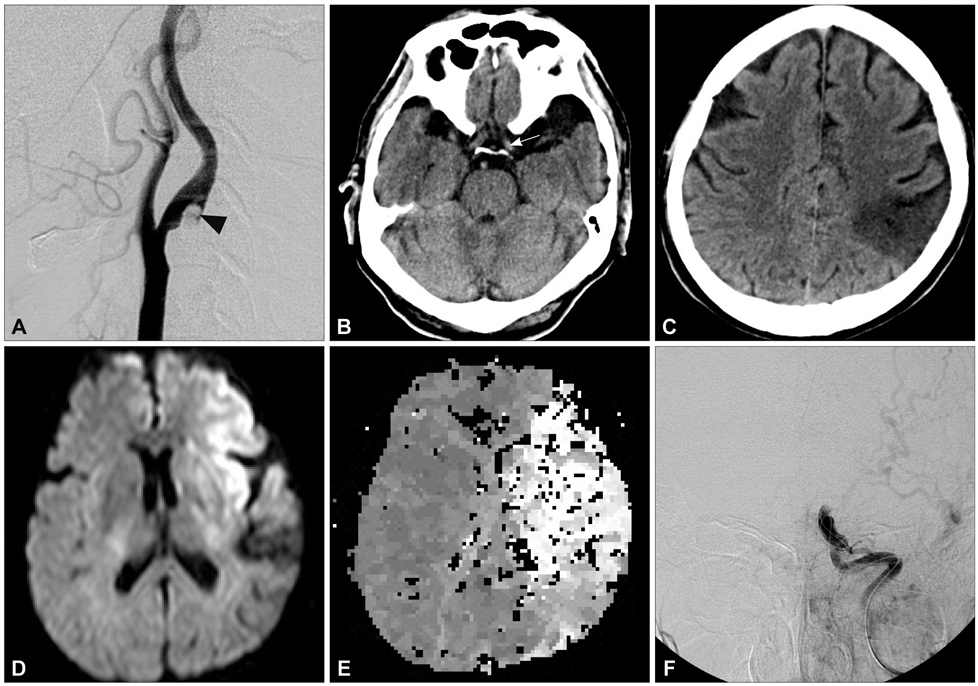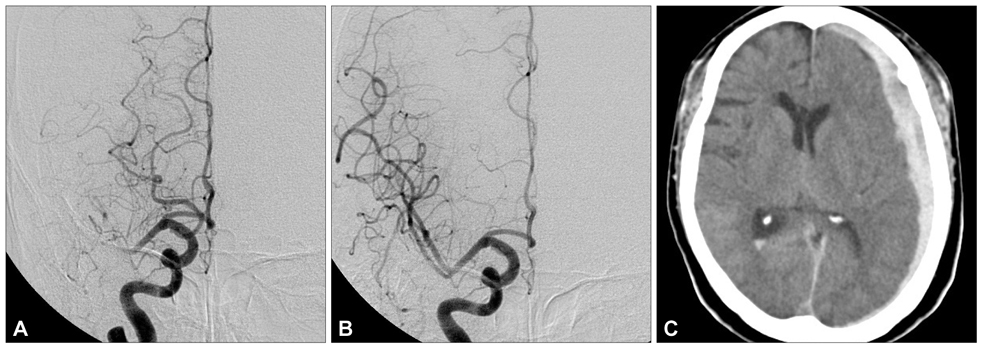J Clin Neurol.
2011 Sep;7(3):159-163. 10.3988/jcn.2011.7.3.159.
Emergency Microsurgical Embolectomy for the Treatment of Acute Intracranial Artery Occlusion: Report of Two Cases
- Affiliations
-
- 1Department of Neurosurgery, School of Medicine, Institute of Wonkwang Medical Science, Wonkwang University, Iksan, Korea. kangsd@wku.ac.kr
- 2Department of Neurosurgery, Gunsan Medical Center, Gunsan, Korea.
- KMID: 2287632
- DOI: http://doi.org/10.3988/jcn.2011.7.3.159
Abstract
- BACKGROUND
The main treatment for acute arterial ischemic stroke is intravenous or intra-arterial thrombolysis within a particular time window. Endovascular mechanical embolectomy is another treatment option in the case of major artery occlusion. Endovascular mechanical embolectomy is a useful technique for restoring blood flow in patients with large-vessel occlusion, and especially in those who are contraindicated for thrombolytics or in whom thrombolytic therapy has failed.
CASE REPORT
We report herein two cases of emergency microsurgical embolectomy for the treatment of acute middle cerebral artery and internal carotid artery occlusion as an alternative treatment for major artery occlusion.
CONCLUSIONS
Emergency microsurgical mechanical embolectomy may be an alternative treatment option for restoring blood flow in selected patients with large-vessel acute ischemic stroke.
Keyword
MeSH Terms
Figure
Reference
-
1. The National Institute of Neurological Disorders and Stroke rt-PA Stroke Study Group. Tissue plasminogen activator for acute ischemic stroke. N Engl J Med. 1995. 333:1581–1587.2. Furlan A, Higashida R, Wechsler L, Gent M, Rowley H, Kase C, et al. Prolyse in Acute Cerebral Thromboembolism. Intra-arterial prourokinase for acute ischemic stroke. The PROACT II study: a randomized controlled trial. JAMA. 1999. 282:2003–2011.
Article3. Adams HP Jr, del Zoppo G, Alberts MJ, Bhatt DL, Brass L, Furlan A, et al. Guidelines for the early management of adults with ischemic stroke: a guideline from the American heart association/American stroke association stroke council, clinical cardiology council, cardiovascular radiology and intervention council, and the atherosclerotic peripheral vascular disease and quality of care outcomes in research interdisciplinary working groups: the American academy of neurology affirms the value of this guideline as an educational tool for neurologists. Stroke. 2007. 38:1655–1711.
Article4. Choi JC, Kang SY, Kang JH, Ko YJ, Bae JM. Are in-Hospital delays important obstacles in thrombolytic therapy following acute ischemic stroke? J Clin Neurol. 2007. 3:71–78.
Article5. Gagliardi R, Benvenuti L, Guizzardi G. Acute operation in cases of middle cerebral artery occlusion. Neurosurgery. 1983. 12:636–639.
Article6. Garrido E, Stein BM. Middle cerebral artery embolectomy. Case report. J Neurosurg. 1976. 44:517–521.7. Khodadad G. Middle cerebral artery embolectomy and prolonged widespread vasospasm. Stroke. 1973. 4:446–450.
Article8. Meyer FB, Piepgras DG, Sundt TM Jr, Yanagihara T. Emergency embolectomy for acute occlusion of the middle cerebral artery. J Neurosurg. 1985. 62:639–647.
Article9. Welch K. Excision of occlusive lesions of the middle cerebral artery. J Neurosurg. 1956. 13:73–80.
Article10. Gobin YP, Starkman S, Duckwiler GR, Grobelny T, Kidwell CS, Jahan R, et al. MERCI 1: a phase 1 study of Mechanical Embolus Removal in Cerebral Ischemia. Stroke. 2004. 35:2848–2854.11. Smith WS, Sung G, Starkman S, Saver JL, Kidwell CS, Gobin YP, et al. Safety and efficacy of mechanical embolectomy in acute ischemic stroke: results of the MERCI trial. Stroke. 2005. 36:1432–1438.
Article12. Touho H, Morisako T, Hashimoto Y, Karasawa J. Embolectomy for acute embolic occlusion of the internal carotid artery bifurcation. Surg Neurol. 1999. 51:313–320.
Article13. Qureshi AI. Endovascular treatment of cerebrovascular diseases and intracranial neoplasms. Lancet. 2004. 363:804–813.
Article14. Smith WS, Sung G, Saver J, Budzik R, Duckwiler G, Liebeskind DS, et al. Mechanical thrombectomy for acute ischemic stroke: final results of the Multi MERCI trial. Stroke. 2008. 39:1205–1212.15. Jansen O, von Kummer R, Forsting M, Hacke W, Sartor K. Thrombolytic therapy in acute occlusion of the intracranial internal carotid artery bifurcation. AJNR Am J Neuroradiol. 1995. 16:1977–1986.16. Horiuchi T, Nitta J, Sakai K, Tanaka Y, Hongo K. Emergency embolectomy for treatment of acute middle cerebral artery occlusion. J Neurosurg. 2007. 106:257–262.
Article
- Full Text Links
- Actions
-
Cited
- CITED
-
- Close
- Share
- Similar articles
-
- Open Embolectomy of an Acute Pulmonary Artery Embolism after Pulmonary Lobectomy
- Surgical Management of Acute Infarction
- Successful Cross-circulation Stent-Retriever Embolectomy Through Posterior Communicating Artery for Acute MCA Occlusion by Using Trevo XP ProVue
- Experimental Microneurosurgical Cerebral Embolectomy:A Time Limit for Cerebral Embolectomy
- Popliteal Artery Occlusion after Total Hip Arthroplasty: A Case Report





